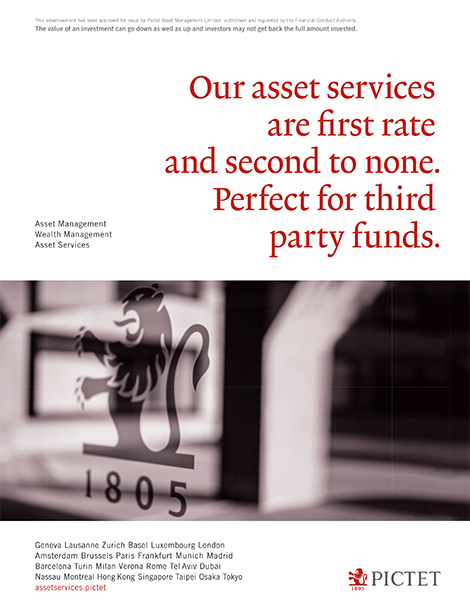How is ESG linked with the securities services industry?
Marie-Laure Schaufelberger: Environmental social and governance (ESG) is a topic that is being talked about widely in recent years within the industry.
The most important aspect is taking into account these extra-financial considerations alongside traditional financial analysis.
Without integrating ESG factors within the investment process, you cannot possibly have a full view of what you’re investing in.
It’s part of your fiduciary duty as an investment manager to take ESG into your decision-making processes. A logical extension of that is giving more transparency to your clients.
Marc Briol: Over recent months, we’ve seen an increasingly strong demand from our clients to get more ESG dimension added into their oversight and they’ve also asked for more monitoring of their investment managers.
We’re also getting interest from the end client. Indeed, more questions and interest are also coming from private clients, who are sensitive to the issue. In addition to this, there is a new generation of people growing up with an understanding of ESG concepts and concerns going forward.
There has been an important shift from investors over the last few years towards opting for more responsible investments, particularly concerning ESG. What changes have you seen in the last few years and how have attitudes toward ESG changed?
Schaufelberger: One thing that is driving this change, in addition to a generational shift, is increased regulatory pressures—as regulators start to ask more questions about the role and responsibility of financial players to take into account the externalities of their investments.
This is prompting institutional clients to demand clear policies and transparency on their implementation. There are also more tools available as well as a better capacity to quantify things that were previously not easy to integrate within an investment process, like environmental or social impacts. In addition, technology has helped by offering more transparency, pushing these issues to the forefront of the debate in our industry.
One of the bottlenecks to having more oversight from an industry perspective, especially from a social and environmental point of view, is the lack of common standards.
Initiatives like the task force for climate-related financial disclosures to develop voluntary, and consistent climate-related financial risk disclosures for use by companies in providing information to investors, lenders, insurers, and other stakeholders are working towards this goal.
Previously, you could simply say you were taking part in ESG initiatives, now, with regulatory reporting requirements, evolving technology and emerging sets of common standards, you have to be able to show how you are actually achieving it.
Briol: What has vanished over the past few years is the optionality of having ESG. If you want to be serious about managing money going forward, then you must include ESG in your investment and reporting processes, this includes the asset servicing process.
The question is how this can be achieved, and obviously which providers will be used to carry out this work. Essentially, to question what the outcomes of the analysis are. The necessity to do this is absolutely clear to me.
What sectors/regions would you say are lacking/excelling in terms of implementing an ESG strategy?
Schaufelberger: From a regional perspective, traditionally Northern Europeans have been at the forefront of integrating these things, especially among institutional clients. But we are seeing expectations start to converge as the European Commission has initiated a comprehensive “Action Plan on Financing Sustainable Growth” in 2017.
There is a clear top-down direction from the European Union on climate benchmarks, the disclosure of ESG and taxonomy.
When we talk about taxonomy and the model we had in the past, we were not using the same language in terms of ESG, sustainability and responsible finance. Now there’s a real effort, especially in Europe to try and establish a common language and common standard.
We are seeing large institutional investors, especially in the US, really catch up fast and demand their asset managers take these things in to account. We’re seeing ESG-disclosure requirements increase from large pension funds in Japan, which will probably have an effect on the rest of Asia in the coming years.
From the sectors perspective, in terms of ESG data, governance is the element that is most standardised. It is also a natural extension of conventional financial analysis, where you have the most data. That’s why in the offering you have the governance tool and the controversy of the metric as well because it is the expression of strong or weak governance.
On the environmental side, you have data that are more readily available, such as carbon benchmarks.
Climate has been dominating the debate. But we shouldn’t forget areas such as water scarcity—that will be a problem in the much nearer future.
The one area where there is more of a challenge is the social side—it’s much more vague. This can mean anything from employee welfare to paying a living wage, of which the latter will vary significantly across different countries. There’s also the consideration of the impact of products on consumers. It is a very heterogeneous space and probably where there is most work to do.
How could ESG strategies benefit a company?
Briol: I don’t think it is about benefiting a company, it’s not a strategy that has been introduced for short term benefits. I think it comes from a sense of conviction.
Companies that may not yet be doing it are may be narrowly focusing on pure financial profits. ESG-related benefits will materialise over the longer-term for the next generation. That’s the purpose when you think about target investments—the companies you choose to invest in for the long-run.
What are you working on at Pictet in terms of ESG?
Schaufelberger: Pictet has been around since 1805 and structured as an independent partnership since inception. We always say the responsibility is part of our DNA and integrating ESG into our financial analysis is a logical extension of this. Fundamentally, if you have a long-term vision of business, by definition, you should be a responsible corporate citizen.
On the asset management side, we’ve integrated ESG considerations across our equity and fixed income strategies, we’re actually now working on integration within our multi-asset and total returns space for this year. It’s a little bit more complex.
On the wealth management side, we have an offering for clients that would be interested in having a more sustainable portfolio or integrating ESG within their portfolios.
More generally, we also manage our environmental footprint and Co2 emissions extremely strictly. We’ve had solar panels on the roof for 10 years. It’s not just products and services, but also how we do business.
Briol: It’s not just from the investment side, it’s other areas as well. We try to walk the walk and talk the talk. We try to make Pictet sustainable, for instance, we’re not taking part in massive amounts of outsourcing on the other side of the world, moving people around to different locations. It’s part of an overall, long-term philosophy, which is different from so many of our competitors.
As far as asset servicing is concerned, we’ll be providing ratings on multiple dimensions using three providers that we’ve partnered up with.
We chose three major ESG rating providers within the market. Our asset management division has worked with these providers for many years, so we knew how they worked. From Sustainanalytics, we chose to look at controversy ratings, environmental assessment ratings and social assessment ratings. We chose ISS to provide governance quality scores and Trucost our carbon performance, including Co2 emissions.
Clients on the asset servicing side can access our e-banking platform and ratings on the various critiques that they have on their portfolio from a reporting standpoint. This allows you to have to have concrete reporting, it’s not just about saying that you’re integrating, it’s about having that transparency and that look-through into your portfolio, which is relatively new in the asset servicing industry.
To what extent do you think the sustained need for transparency corresponds with social governance in particular, especially since the financial crash of 2008?
Schaufelberger: The financial crisis was the ultimate failure in governance, a demonstration of what happens when financial businesses do things for money’s sake, instead of doing them for the reasons why they’re there, servicing clients and ensuring that we have a well-functioning financial system and economy.
After the crisis, there was the creation of the Financial Stability Board, who looked at the underlying governance and various other issues that had led to this crisis. It also looked at fostering the transparency needed to be injected into the system to ensure a crash of that scale wouldn’t happen again.
And on top of that, you had all these new challenges that were coming up, with the environment. You had the sustainable development goals in 2015 and the Paris Agreement in the same year. These initiatives show that in the past decade, there’s a shared notion that we need to go toward a better system, and toward a financial system that fosters a better planet and better conditions for people. That will be conducive to more stability. You need stability for a stable economy and a healthy planet. Increased transparency is also necessary for that virtuous circle.
Are you working with others in the industry on this initiative?
Briol: We are working with and for our clients. The day you send out transparency rules on portfolios, our clients will get questions from their clients. They get questions from their boards, pension funds and investors. We’ve seen a lot of people start to have the debate and that’s our ambition.
Schaufelberger: Apart from the partnerships we already have with various stakeholders, and the ongoing partnership we have with our clients, it’s important to know the number of industry initiatives are broadly asking ESG questions.
We also work collaboratively on sustainable finance. Specifically, we’ve worked with Swiss Sustainable Finance to drive an initiative to send a letter to global Index providers to ask them to exclude controversial weapons from mainstream indices.
These controversial weapons indices have largely been excluded by international conventions and most European institutional investors today are actually excluding them from their portfolios.
When we have passive replication, we have to replicate the index. Therefore, if there are controversial weapon manufacturers in the index, we’re replicating that as well.
So, you may exclude it on the active side, but on your passive side, you’re exposed.
Swiss Sustainable Finance now has 145 signatories that have signed this initiative, representing about $6.9 trillion. The initiative is still open for signatories. The idea is to get the major index providers to look at how they could potentially exclude these controversial weapon manufacturers. It’s interesting how far you can actually take engagement and industry collaboration on different issues linked with ESG in order to foster systemic change.



